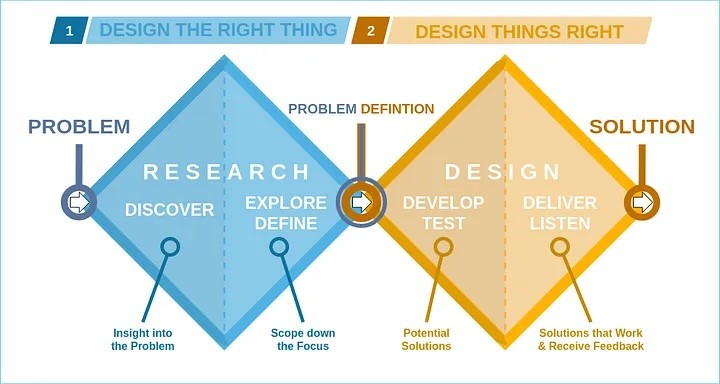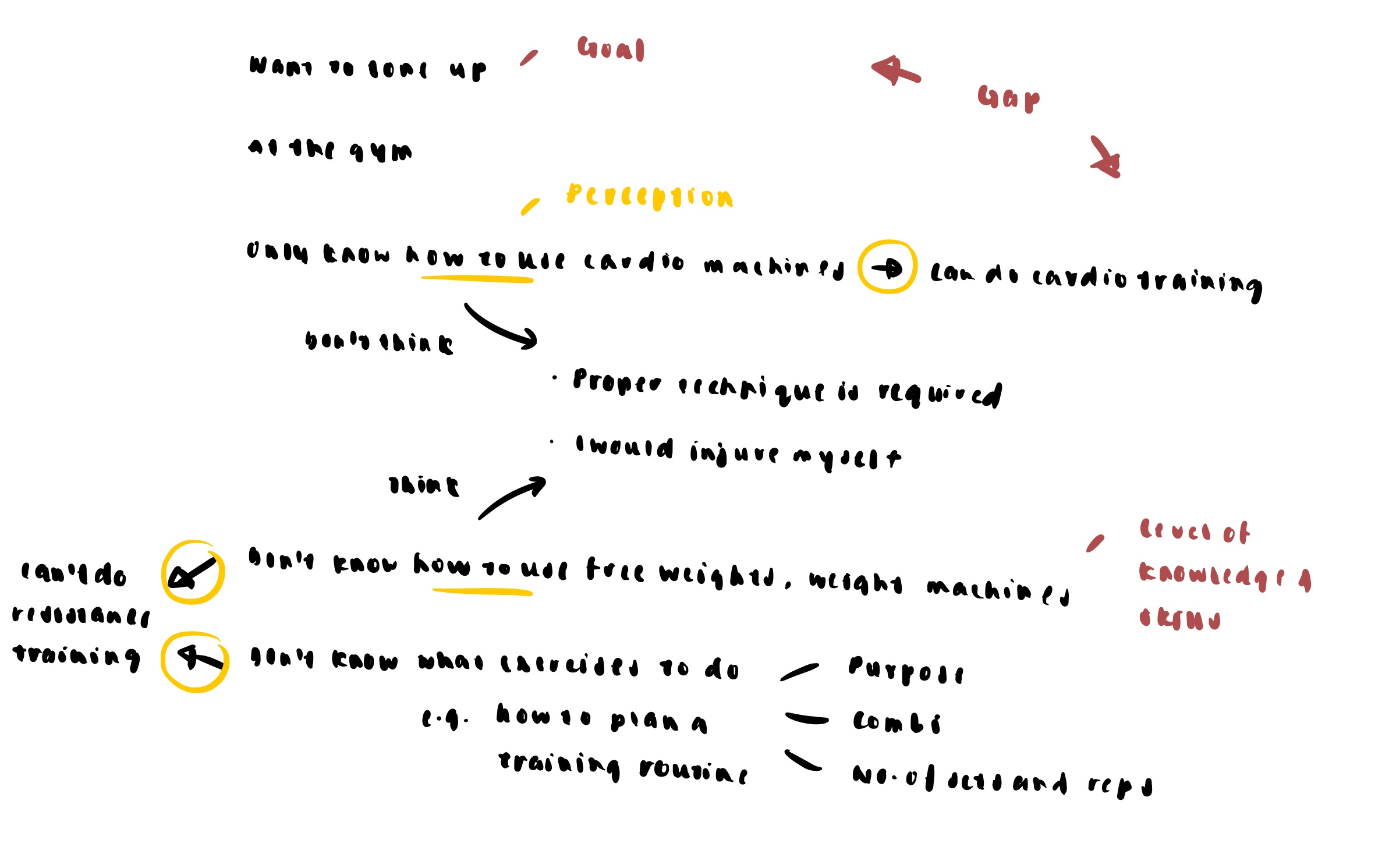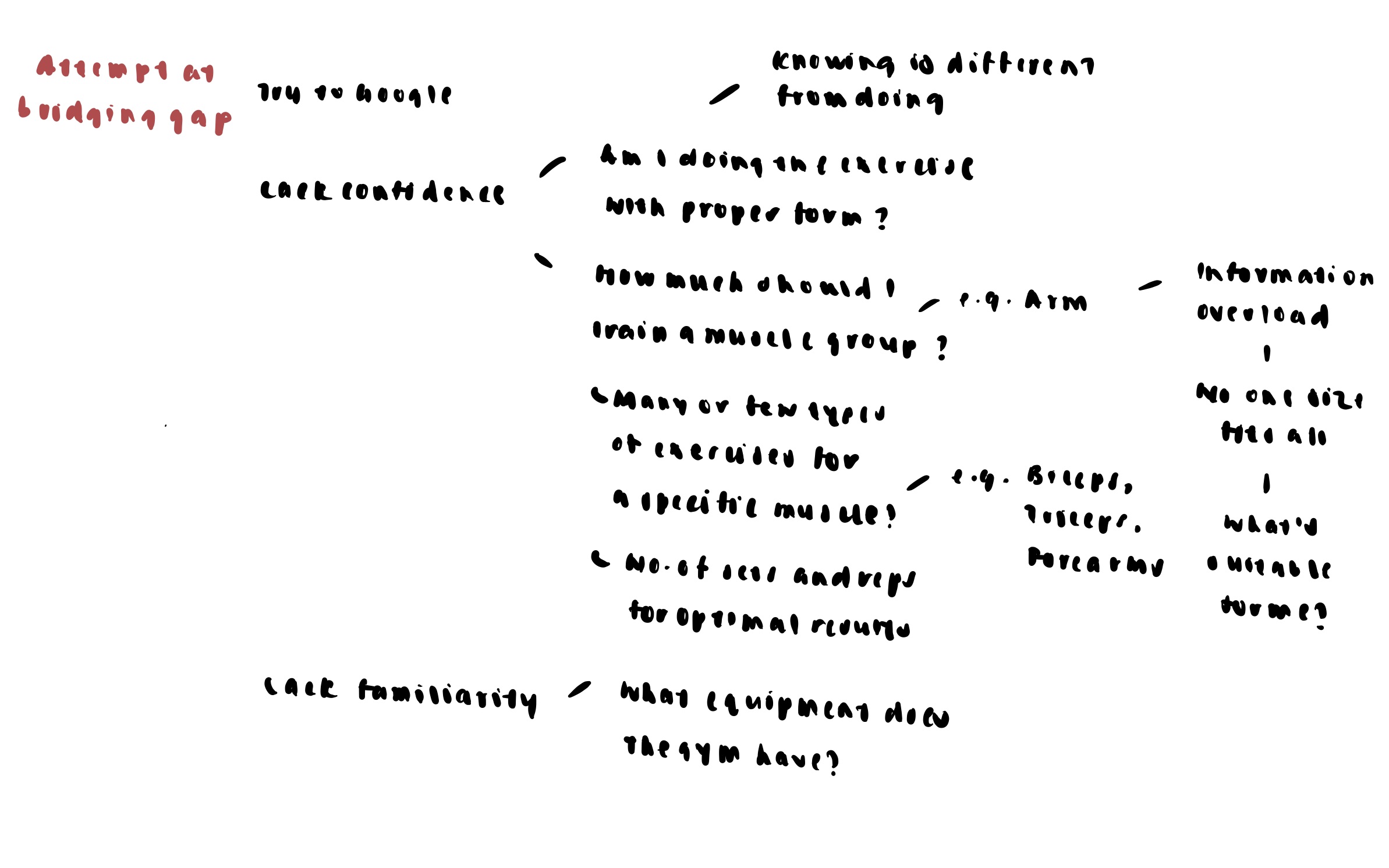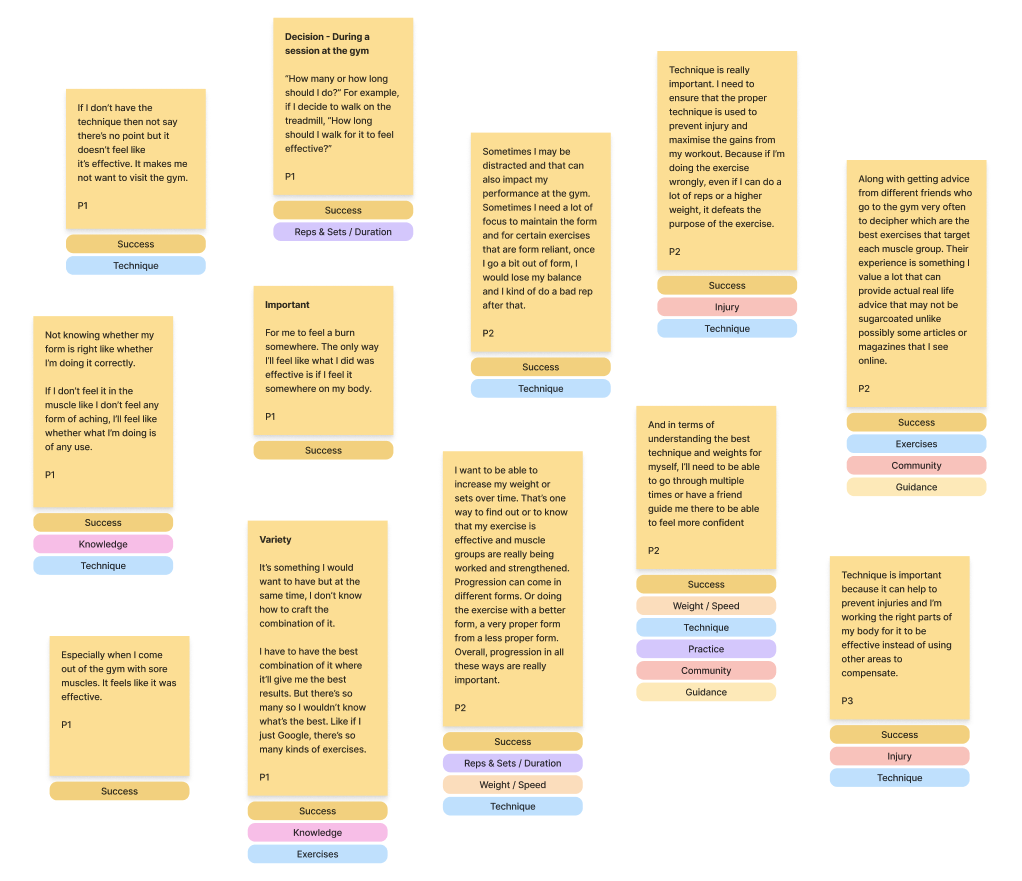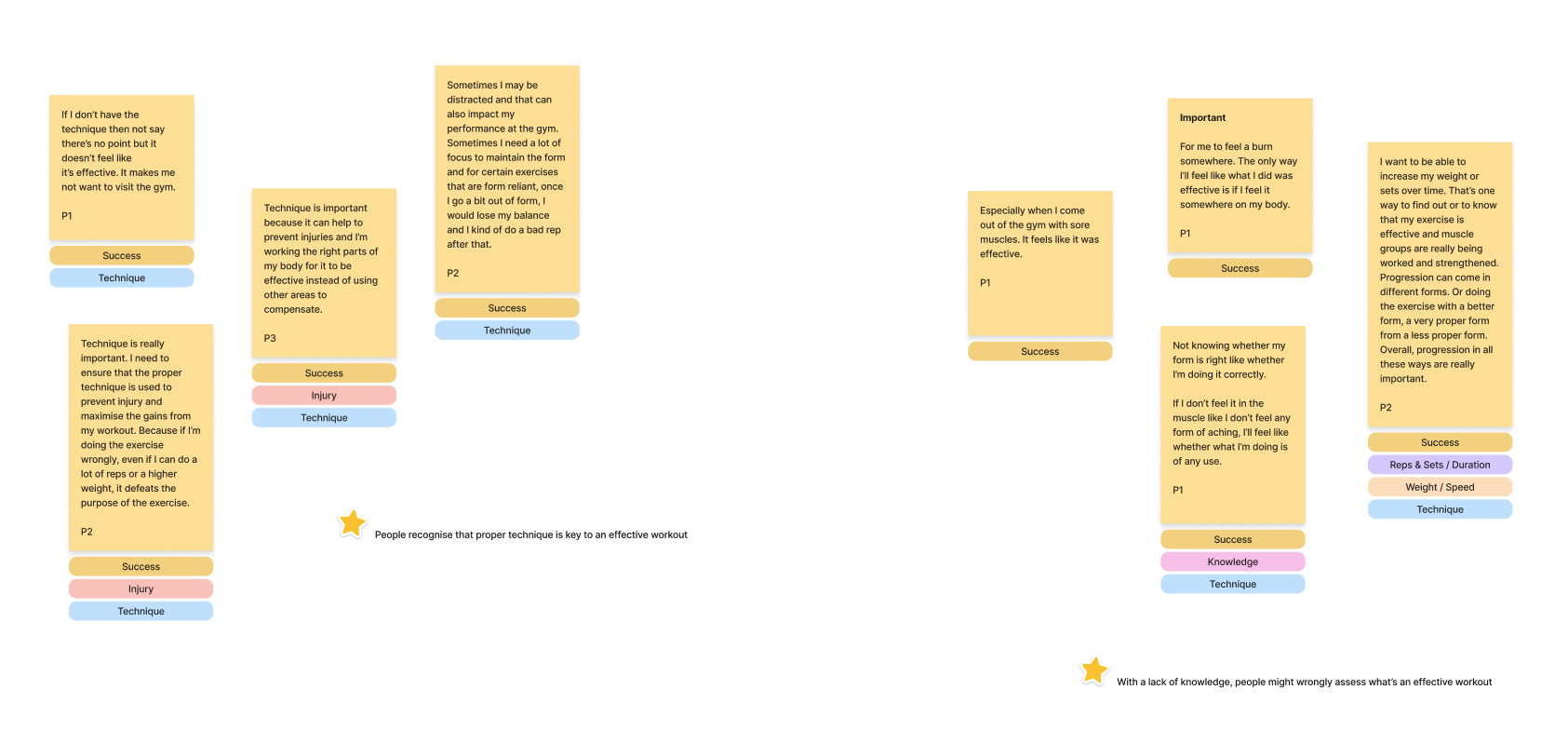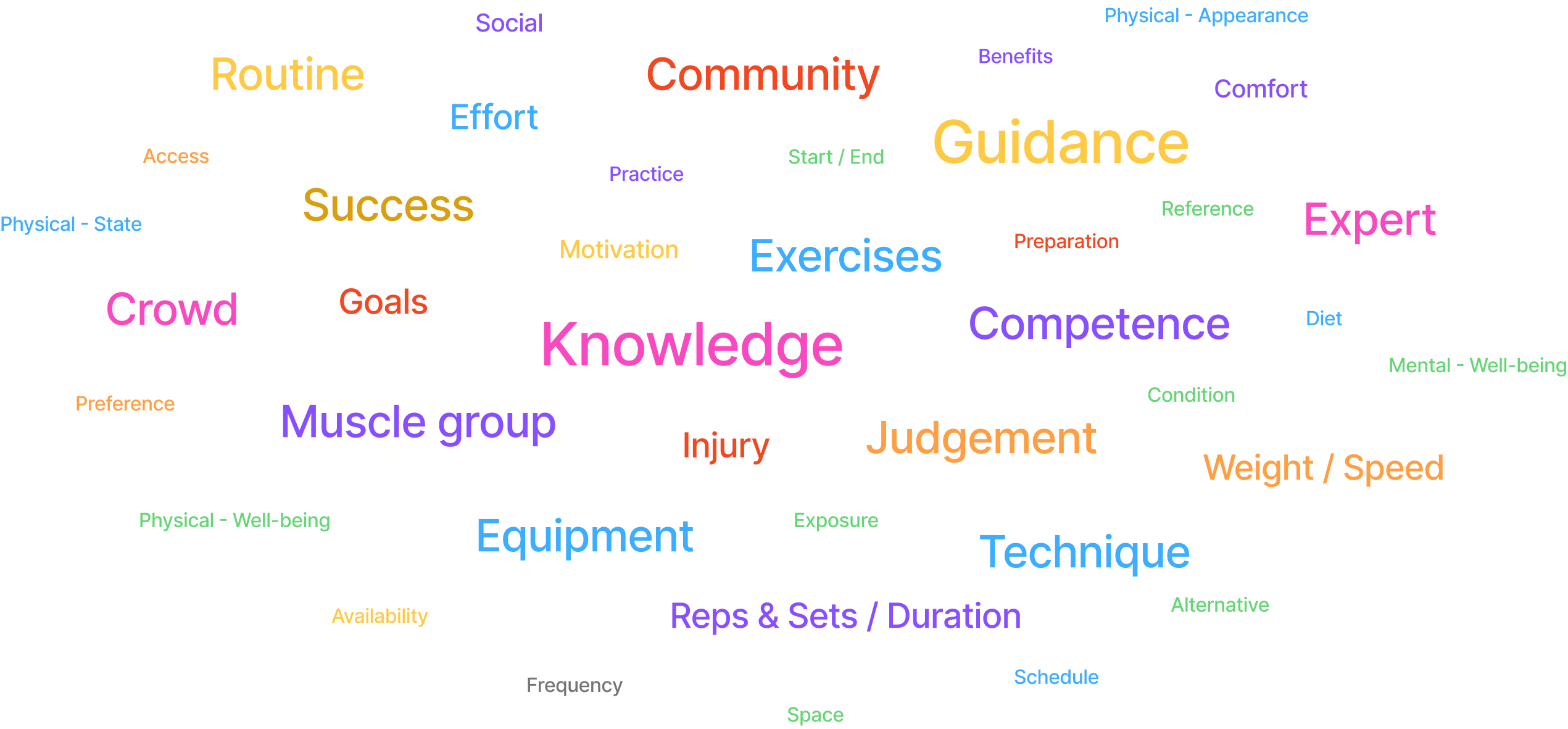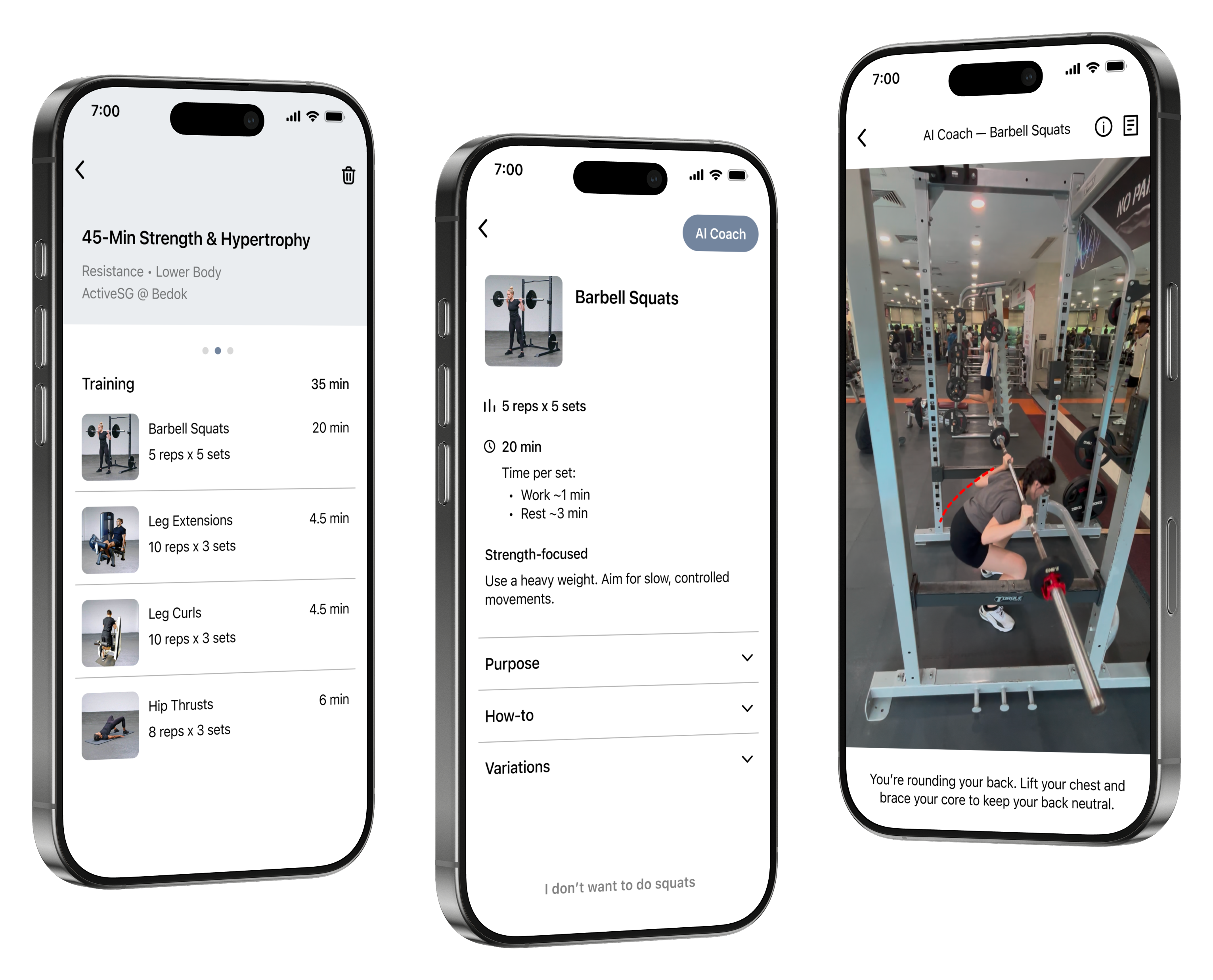
Gymer
Overview
Gymer empowers gym-goers of all levels to reach their training goals with a workout builder and personalised, guided workouts that remove any guesswork and enhance their performance at the gym.
Process
Using the Double Diamond framework to structure my design process and outline key activities for each phase
Discover phase:
-
User Research
-
Domain Research
Explore / Define phase:
-
Synthesis
-
Problem Statement
Develop / Test phase:
-
Ideation
-
Wireframing & Prototyping
-
Testing
-
Iteration
Deliver phase:
-
Next Steps
Problem Statement
- Preliminary
From there, I crafted a problem statement to guide my research.
"New gym-goers lack knowledge and skills when it comes to training. It brings them stress, fear and anxiety when they visit the gym."
New gym-goers
How about regular gym-goers?
Knowledge and skills
What kind of knowledge and skills?
Training
What aspects of training?
Stress, fear and anxiety
True / False?
User Research
To inform my research, I conducted User Interviews with three gym-goers, each lasting approximately 45 minutes.
Research Goals
-
What motivates new / regular gym-goers to visit the gym? What demotivates them?
Which one outweighs the other?
To get a sense of: Knowledge, Skills
-
How do new / regular gym-goers approach training?
What decisions do they make? Their decision-making process
-
What aspects of training do new / regular gym-goers care about?
What's important to them?
To understand the cause and effect of: Stress, Fear, Anxiety, Others
-
What are the highs and lows of new / regular gym-goers' experiences?
What challenges do they face? How have they tried to overcome it?
-
What kind of support do new / regular gym-goers need?
To shape the app's features
Interview Guide
-
How often do you visit the gym? Why?
-
What motivates you to visit the gym? Please explain. On the other hand, what demotivates you? Please explain.
-
Tell me about the last time you went to the gym.
-
How often do you follow a routine? Why?
-
What types of training do you do? Why?
-
What areas of the body do you train? Why?
-
What types of exercises do you do? Why?
-
What types of equipment do you use? Why?
-
How long do you train? Why?
-
Please describe your experience.
-
(Any challenges) You mentioned… How have you tried to overcome it? How do you feel about it?
-
-
Walk me through the decisions you make before, during and after a session at the gym. What factors influence each of these decisions?
-
(Types of training) e.g. Cardio vs. Resistance, Push / Pull, Upper / Lower vs. Full body; Do you prefer certain types of training over others? Why?
-
(Areas of the body) e.g. One area vs. Multiple areas
-
(Types of exercises) e.g. Tried and true vs. New, Compound vs. Isolation, Body weight vs. Weights; Do you prefer certain types of exercises over others? Why?
-
(Types of equipment) e.g. Tried and true vs. New; Do you prefer certain types of equipment over others? Why?
-
(Duration of training) e.g. Rigid vs. Flexible
-
-
What’s important to you when you train? Please explain.
-
What do you think about technique in your workout? Why?
-
What do you think about variety in your workout? Why?
-
What do you think about progression in your workout? Why?
-
-
On a scale of 1 to 10 (1 - Least and 10 - Most), how would you rate your level of confidence at the gym? Please explain.
-
What would bring your level of confidence at the gym from a _ to a 10? Why?
-
-
On a scale of 1 to 10 (1 - Least and 10 - Most), how would you rate your level of familiarity with the gym? Please explain.
-
What would bring your level of familiarity with the gym from a _ to a 10? Why?
-
-
What tools or resources do you use to help you at the gym? Why?
-
Please describe your experience.
-
-
If you could create an app to help you at the gym, what features would it have? Please explain.
Synthesis
Using Thematic Analysis, I was able to uncover key insights that revealed common pain points and unmet needs among gym-goers.
Step 1
Tagging segments of text with labels
Example:
What the participant says
Label
-
Not knowing whether my form is right like whether I’m doing it correctly.
Technique
Knowledge
-
Usually because I’m at the gym with my friend, I’ll ask them to help me to check.
Technique
Community
Guidance
-
If I don’t feel it in the muscle like I don’t feel any form of aching, I’ll feel like whether what I’m doing is of any use.
Technique
Success
-
A bit conscious if there’s other people around.
Technique
Crowd
Judgement
Step 2
Comparing segments of text within and between each label
Example:
-
I gathered all segments of text with the label 'Success'.
-
Then, I organised these segments of text into clusters. From these clusters, I was able to identify patterns that led to meaningful insights.
Label
Success
Insight
-
People recognise that proper technique is key to an effective workout
-
People believe that their choice of exercises, reps & sets / duration and weight / speed play a role in an effective workout
-
With a lack of knowledge, people might wrongly assess what's an effective workout
Result
Based on 40 labels, the following insights, thoughts and questions emerged:
Insight
-
Physical appearance, physical well-being i.e. health and fitness and mental well-being are reasons people feel motivated to visit the gym
-
Question: How can people set clear goals and take actionable steps at the gym?
-
Effort is a reason people feel demotivated to visit the gym
-
Thought: How might we decrease the perceived effort?
-
At the gym, people rely on a community for:
-
Guidance
-
A lack of knowledge
-
With regards to: What exercises to do, How to use equipment, What proper technique looks like, What’s the recommended weight / speed, etc.
-
The need for feedback
-
From those who visit the gym more often and seem knowledgeable
-
-
Comfort
-
To feel at ease
-
-
Motivation
-
To keep going
-
-
Social
-
To engage with others
-
-
At the gym, people rely on an expert for:
-
Guidance
-
A lack of knowledge
-
With regards to: How to use equipment, What proper technique looks like, What’s the recommended reps & sets / duration, etc.
-
The need for feedback
-
From those who are knowledgeable
-
-
People seek guidance from a community and/or an expert:
-
With regards to:
-
Exercises - What exercises to do
-
Equipment - How to use equipment
-
Technique - What proper technique looks like
-
Reps & Sets / Duration - What’s the recommended reps & sets / duration
-
Weight / Speed - What’s the recommended weight / speed
-
-
To boost their confidence
-
A lack of knowledge
-
With regards to:
-
Exercises - Purpose of exercises, What exercises to do
-
Equipment - Types of equipment, How to use equipment
-
Technique - What proper technique looks like
-
-
When it comes to having others at the gym, people worry about:
-
Judgement - Especially new gym-goers
-
Perceived competence of others > Perceived competence of self
-
“We think they know what they’re doing. We worry that they think we don’t know what we’re doing.”
-
The urge to avoid mistakes or delays
-
Might deter them from trying new exercises, trying new equipment and finding references
-
-
Availability - New and regular gym-goers
-
Lack of equipment
-
Might cause a change of plans
-
-
Thought: Can knowledge help people overcome the fear of judgement? How might we increase the perceived competence of self?
-
People value competence at the gym. While some worry about judgement, others seek guidance from those who seem knowledgeable.
-
People recognise that proper technique is key to an effective workout
-
People believe that their choice of exercises, reps & sets / duration and weight / speed play a role in an effective workout
-
Question: What determines an effective workout?
-
With a lack of knowledge, people might wrongly assess what’s an effective workout
-
Question: What makes an effective workout?
-
Some people plan a routine with a clear structure to it while others don’t and want a feature that helps them with it
-
Question: What are some ways to plan a routine at the gym?
-
People expect a routine to target specific muscle groups and to include a range of exercises
-
Being knowledgeable about various equipment expands the range of exercises one can do
-
More knowledge about equipment → More choices for exercises
-
-
The importance of flexibility in exercises to cater to preferences, ability and limitations
-
People are keen to surpass their personal best in reps & sets / duration and weight / speed
-
A balance between reps & sets / duration and weight / speed - Either increase / decrease one or the other
-
While some make preparations before they visit the gym, others don’t
-
People rely on references to make preparations
-
Physical and online references e.g. Instruction labels, magazines, YouTube / TikTok, etc.
-
People prefer real-time, hands-on guidance over static, one-way references
-
People opt for references that are efficient and easy to understand
-
An individual’s schedule on a given day can affect the start / end time and how long they visit the gym
-
An individual’s condition on a given day can affect their decision to visit the gym and their choice of exercises, reps & sets / duration and weight / speed
-
At the gym, people worry about injury
-
Question: How can people avoid injury at the gym?
-
Factors that affect how often people visit the gym:
-
Community e.g. Family, friends, etc.
-
Knowledge
-
-
People visit the gym less often as they turn to alternatives like BFT
-
People turn to alternatives like BFT as they prefer group training over individual training
-
People turn to alternatives in search of guidance
-
The need for practice in order to do without guidance
-
People recognise that diet and training go hand in hand at the gym
See Figma
Problem Statement
- Final
With newfound insights, I reframed the problem statement to align with gym-goers' realities.
"New gym-goers often lack the knowledge and skills needed to train safely and effectively. The risk of injury and the fear of judgement make them hesitant to fully engage in their workouts. As a result, they rely on a community and/or an expert for guidance."
How Might We Statement
From there, I crafted a HMW statement to transform the problem into a clear, actionable design opportunity.
"How might we empower gym-goers with the knowledge and skills needed so that they feel confident and are self-reliant in their workouts?"
User Stories
Then, I developed user stories that served as a springboard for my ideation.
-
As a gym-goer, I want to know what exercises to do for a muscle group so that I can target the muscle group
-
As a gym-goer, I want to know what exercises to do together so that I can train effectively
-
As a gym-goer, I want to follow muscle group pairings so that I can train efficiently and allow for optimal muscle recovery + well-rounded muscle development
-
As a gym-goer, I want to tailor my workouts with modified exercises so that I can train according to my ability or limitations
-
As a gym-goer, I want to tailor my workouts with alternative exercises so that I can train according to my preferences
-
As a gym-goer, I want to know the purpose of each exercise so that I can engage the right muscles
-
As a gym-goer, I want to know how to use equipment so that I can train safely, effectively and efficiently
-
As a gym-goer, I want to be familiar with more equipment so that I can incorporate more exercises in my workouts
-
As a gym-goer, I want to know about safety features of equipment so that I can avoid injury
-
As a gym-goer, I want to tailor my workouts to equipment at my location so that I can train anywhere
-
As a gym-goer, I want to know what proper technique looks like so that I can train safely, effectively and efficiently
-
As a gym-goer, I want to get real-time feedback on my technique so that I can improve as I train
-
As a gym-goer, I want to get personalised feedback on my technique so that I know exactly how to improve
-
As a gym-goer, I want to know what’s the recommended reps & sets so that I can train safely, effectively and efficiently
-
As a gym-goer, I want to know what’s the recommended weight so that I can train safely, effectively and efficiently
-
As a gym-goer, I want to know how to balance reps, sets and weight so that I can make progress in my workouts
-
As a gym-goer, I want to visit the gym anytime so that I can train according to my schedule
-
As a gym-goer, I want to visit the gym for any duration so that I can train according to my schedule
-
As a gym-goer, I want to choose my focus of training e.g. Cardio vs. Resistance, Upper body vs. Lower body, etc. so that I can reach my goals
Domain Research
See Figma
Ideation
Based on the user stories, I captured all ideas—big and small—that came to mind, allowing for a broad exploration of potential solutions.
Solution
The solution consists of two parts—a workout builder and personalised, guided workouts.
A workout builder
-
Lets users set:
-
Duration of workout - Based on their available time
-
Focus of workout - Based on their training goals
-
Location of workout - Tied to their available equipment
-
-
Lets users get:
-
Curated exercises
-
See Figma
Design decisions
Gymer's workout builder aligns with users’ mental models by taking them through a simple, question-based flow that mirrors how they naturally plan their workouts.
In the first step, users choose the duration of their workouts, ranging from 15 to 90 min.
A minimum of 15 min encourages activity even when time is limited while still being sufficient for training, recovery, warm up and cool down. A maximum of 90 min prevents overtraining.
In the second step, users choose the focus of their workouts, having options like 'Cardio', 'Resistance' and 'Cardio + Resistance'.
With 'Cardio', users are led directly to the third step. With 'Resistance', a follow-up question is asked regarding the muscle groups to target. With 'Cardio + Resistance', two follow-up questions are asked regarding the cardio-to-resistance ratio and the muscle groups to target.
Muscle groups are organised by movement patterns instead of being listed individually. Not only does it aid users' decision-making, especially for those who lack knowledge of anatomy or how muscle groups work together, it also supports better training outcomes through balanced, effective and efficient routines.
Personalised, guided workouts
-
Ad-hoc format - No fixed plan; Workouts are session-based
-
Comprehensive training details
-
Exercise - Reps & sets, work / rest intervals, weight, tempo
-
Equipment - Set up
-
Technique - Form, engagement, breathing
-
-
Adaptive approach - Able to swap exercises; Workouts tailor to each user
-
Smart training assistance
-
AI Coach - Audio & visual feedback
-
See Figma
Design decisions
Gymer's workout algorithm assigns training programs like 'Strength & Hypertrophy', 'HIIT', 'Concurrent Training', etc. to users and pulls curated exercises from a structured library.
Users are able to create their workouts in advance to access training details anytime.
Users are able to create their workouts on an ad-hoc basis, with the flexibility to repeat, or delete and start fresh each session.
Each exercise comes with recommended reps, sets, work/rest intervals, weight and/or tempo based on a given training program.
Training details like these which vary by workout are placed at the top of the screen for clear visibility at the start of each session. The ones which remain the same across workouts like the exercise's purpose, how-to, etc. are placed in accordions. Users are able to access guidance when needed and bypass when not.
Muscle groups are colour-coded and labeled for quick recognition of which areas each exercise works.
Training details here are organised in a way that supports quick scanning while allowing for in-depth exploration when needed. Firstly, the 'How-to' section is broken into sub-sections like 'Equipment', 'Tutorial', 'Fundamentals' and 'Safety' with further granularity through sub-subsections like 'Set up', 'Form', 'Engagement' and 'Breathing' so that users are able to access guidance based on their goals or challenges. Secondly, the design incorporates multi-modal learning. A video is available for users seeking a walkthrough with detailed, step-by-step instructions, while images or GIFs accompanied by descriptions are available for users seeking a refresher through concise, modular instructions.
Modified exercises are shown at a glance, allowing users to self-assess and follow a clear path of progression or regression to scale their workouts as needed.
Users are able to learn about modified exercises before committing to a swap or take action immediately.
Alternative exercises are shown when users tap 'I don't want to do _', a prompt that mirrors how users naturally communicate. By separating modified exercises which cater to their abilities and limitations from alternative exercises which cater to their preferences, users aren't overwhelmed by too many options at once. Additionally, alternative exercises are shown individually, allowing users to thoughtfully consider each option.
Users are able to learn about alternative exercises before committing to a swap or take action immediately.
Guidelines are shown upfront, allowing users to make preparations and ensure the AI Coach works as intended for training assistance.
Within the AI Coach, users are able to access an explanation of the feature, the aforementioned guidelines and a refresher on the exercise's how-to, all without leaving the interface, thereby receiving just-in-time help without any interruption to their workouts.
Training assistance is provided through audio and visual feedback that highlights mistakes, suggests ways to improve and/or provides reference points.
e.g.
-
Feedback 1
-
"Adjust your grip" → Way to improve
-
"Your hands should be roughly shoulder-width apart" → Reference point
-
-
Feedback 2
-
"You're rounding your back" → Mistake
-
"Lift your chest and brace your core to keep your back neutral" → Way to improve
-
-
Feedback 3
-
"Your knees are collapsing" → Mistake
-
"Keep your knees in line with your toes" → Reference point
-
Testing
Throughout the project, I conducted two rounds of testing—Guerrilla Testing on a feature midway through wireframing to collect early feedback and Usability Testing on the app at the end to evaluate the overall user experience.
See Figma
Iteration
To address the feedback from testing, I made three design changes.
Design changes
To convey that exercises here are meant for progression and regression
-
'Modifications' has been replaced with 'Variations'
-
'Level' is added to each label
Next Steps
Following the launch of Gymer, I plan to collect additional feedback from gym-goers, particularly through Diary Studies, to understand how they integrate the app into their daily lives. Apart from assessing the app's value and usability, I'd like to explore the following areas:
-
Whether there's a need for alternative exercises during warm up and cool down
-
How gym-goers might interact with the AI Coach in a real gym environment
-
Whether users prefer to save AI Coach recordings within the app or to their device's gallery
Based on the feedback from testing, I'd iterate on the design. Additional changes might be needed to address technical constraints or enhance the app's performance.
Try it out!
See Figma
